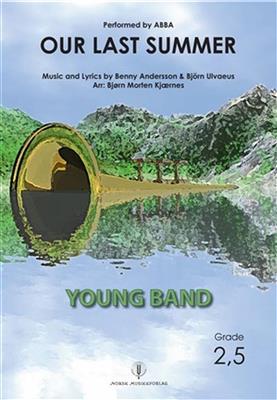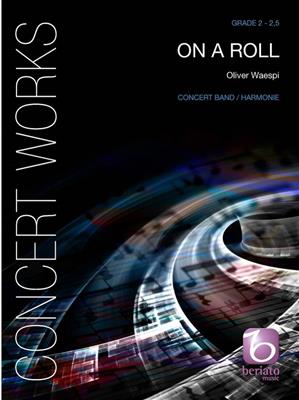Results
-
 £60.50
£60.50Breakneck! - Tyler Arcari
Imagine flying down the streets at breakneck speed! This high-wire work for developing bands is an intense ride from start to finish! Easy 8th-note patterns create an anchor-point for this work while a clever use of percussion equipment, upper brass "honks", and cool harmonic tension transport you behind directly behind the wheel!
Estimated dispatch 7-14 working days
-
 £115.60
£115.60Infinity Forest - Haakon Esplo
The concert overture "Infinity Forest" draws inspiration from an ancient forest, standing majestically, enveloped in mystery and secrets. Venturing into this forest, one never knows what awaits. It lies dark and quiet, interrupted by clearings where the sunlight breaks through."Infinity Forest" serves as a magnificent opening for any concert and is equally an excellent choice for competition repertoire. The music presents challenges of both technical and musical nature for all instrument groups, offering great opportunities to focus on precision, timbres, and intonation. While the lower parts are designed for easier difficulty, the lead parts present greater challenges.A simplified part for flute and horn has also been made available, instruments which traditionally only have one part in the Young Band series.
Estimated dispatch 7-14 working days
-
 £115.60
£115.60Our Last Summer - Benny Andersson
An exciting arrangement where almost all players have a bit of the melody line. There are many opportunities to give individual musicians soloistic challenges. Any bandmember should find something interesting in this piece. It will be possible to add vocals to the arrangement. A lovely melody with great expressions.Our Last Summer" is a song by the Swedish pop group ABBA from their seventh studio album, "Super Trouper," released in 1980. The song is indeed featured in the musical "Mamma Mia!", a little bit shortened and with small changes in the lyrics. The musical premiered in London's West End in 1999 and is a duet performed by the characters Harry Bright and Donna Sheridan, reflecting on their past romance during a summer spent in Paris.The song is primarily sung by Bjrn Ulvaeus, with backing vocals provided by Agnetha Fltskog and Anni-Frid Lyngstad, the female members of ABBA. Their harmonies contribute to the song's nostalgic and wistful atmosphere. The lyrics vividly describe the memories of the summer spent together, including scenes of walking along the Seine River in Paris and listening to French songs. The song also touches on the passage of time and the realization that the summer romance has ended.While not released as an official single in most countries, "Our Last Summer" still received considerable airplay and became a fan favorite. It charted in some European countries and has remained popular among ABBA fans over the years.
Estimated dispatch 7-14 working days
-
 £128.60
£128.60Det e min snn - Lars Bremnes
The composer's sister, Kari Bremnes, has had great success with this song through her album "Det vi har" from 2017. Subsequently, Elisabeth Andreassen has also performed it on the TV program "Hver gang vi mtes".The lyrics are about the thoughts one has when their son has to leave for military service and the new life it brings in an increasingly uncertain world.Lars Bremnes has been a soloist with the bands of the Norwegian Armed Forces several times, and this arrangement is written for such an occasion.
Estimated dispatch 7-14 working days
-
 £60.99
£60.99Journey (Paddle Song) - Chief Ian Campbell
In partnership with Squamish First Nation Chief Ian Campbell, Robert Buckley has creatively re-imagined this haunting melody for full concert band. Journey features an underlying rhythmic pulse over which the melody evolves in a variety of moods and textures. The end result is quite dramatic and offers a rare glimpse of an ancient culture. Dur: ca. 3:20
Estimated dispatch 7-14 working days
-
 £53.50
£53.50Orenda! (The Power Within) - Michael Sweeney
Originating from the Iroquois Native Americans, the term Orenda describes an extraordinary and mystical force within all people that empowers us to affect positive change. From the chant-like opening strains to the faster section with its driving pulse, this mature sounding piece for young players offers an emotional and rewarding musical experience. Dur: ca. 2:45
Estimated dispatch 7-14 working days
-
 £60.99
£60.99Afro Blue - Mongo Santamaria
Composed in 1959 by Mongo Santamaria, Afro Blue became one of the earliest jazz standards written in an Afro-Cuban style. This creative setting for concert band utilizes the African bemb rhythm, along with characteristic melodies and harmonies alternating between various sections of the band. Also a great vehicle for engaging your percussion section while introducing your students to an important and appealing musical genre. Dur: ca. 2:30
Estimated dispatch 7-14 working days
-
 £53.50
£53.50Mystic Passage - Michael Oare
Representing a musical journey through an enchanting and mysterious realm, Mystic Passage unfolds with a soft and evocative atmosphere of intrigue and anticipation. As the intensity gradually escalates, the listener encounters a series of twists and turns through this magical world. An engaging and creative work for 2nd year players. Dur: ca. 2:30
Estimated dispatch 7-14 working days
-
 £199.99
£199.99Suite Pastorale - Franco Cesarini
Suite Pastorale, made up of three movements - Idyll, Playful Shepherd Boys, Rain Upon the Fields - is characterized by an idealization of the simplicity of country life in close contact with nature. Suite Pastorale depicts the eternal and fascinating myth of Arcadia: a world in which man lives in harmony with nature, immersed in bucolic forest landscapes, one of the most important imaginary places to escape to for those who were, and still are, tired of culture and civilization. The evocative Arcadian world is made almost mythological by the attention dedicated to it by poets, writers, playwrights, painters, and composers who over the centuries have drawn lifeblood from it for their works. Full of metaphorical meanings, it is a place of shelter, a place to live and sing about love, even if it means disappointment, and it is the place of civilization opposed to barbarism. It is a symbol of happiness, a real and intact image of reality, motionless in space and time, where nothing changes. The myth of the "locus amoenus" has not disappeared but has kept all its charm intact over the centuries.Suite Pastorale was commissioned to Franco Cesarini by the concert band of Aldeno (Trento/Italy) for the 100th anniversary of its foundation (1923-2023.Suite Pastorale: an ideal concert piece that will delight your audience!
Estimated dispatch 7-14 working days
-
 £68.99
£68.99On a Roll - Oliver Waespi
The title of this piece reflects its upbeat, forward-driven character. It starts out with a soul groove, carrying a prominent theme which invites players and listeners to dance. The slower middle section features a blues with optional solo parts. After the return of the soul beat, the piece concludes with a striking reaffirmation of the initial theme. On a Roll may be performed as an effective opener or as an upbeat rhythm item during a concert or contest. On a Roll was commissioned by the Zrcher Blasmusikverband for the Zrcher Kantonalmusikfest 2024 in Urdorf/Schlieren, Switzerland.
Estimated dispatch 7-14 working days
